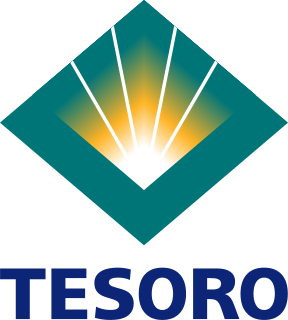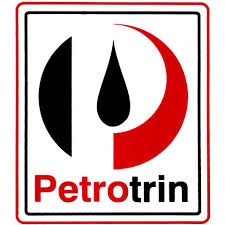
Amoco is a brand of petrol stations operating in the eastern United States, and owned by British company BP since 1998. The "Amoco Corporation" was an American chemical and oil company that was founded in 1889, around a refinery located in Whiting, Indiana, United States. Part of the Standard Oil Trust, it focused on gasoline for the new automobile market. In 1911, during the breakup of the trust, it became an independent corporation. Incorporated in Indiana, it was headquartered in Chicago. Amoco merged operations with BP in 1998.

Mandan is a city on the eastern border of Morton County and the eighth-largest city in North Dakota. Founded in 1879 on the west side of the upper Missouri River, it was designated in 1881 as the county seat of Morton County. The U.S. Census Bureau estimated the 2020 population at 22,857. Across the Missouri River from Bismarck, Mandan is a core city of the Bismarck-Mandan Metropolitan Statistical Area.

An oil refinery or petroleum refinery is an industrial process plant where crude oil is transformed and refined into useful products such as petroleum naphtha, gasoline, diesel fuel, asphalt base, heating oil, kerosene, liquefied petroleum gas, jet fuel and fuel oils. Petrochemicals feedstock like ethylene and propylene can also be produced directly by cracking crude oil without the need of using refined products of crude oil such as naphtha. The crude oil feedstock has typically been processed by an oil production plant. There is usually an oil depot at or near an oil refinery for the storage of incoming crude oil feedstock as well as bulk liquid products. According to the Oil and Gas Journal, on 31 December 2014, a total of 636 refineries operated worldwide with a total daily capacity of 87.75 million barrels (13,951,000 m3).

Tesoro Corporation, known briefly as Andeavor, was a Fortune 100 and a Fortune Global 500 company headquartered in San Antonio, Texas, with 2017 annual revenues of $35 billion, and over 14,000 employees worldwide. Based on 2017 revenue, the company ranked No. 90 in the 2018 Fortune 500 list of the largest United States corporations by total revenue.

Marathon Petroleum Corporation is an American petroleum refining, marketing, and transportation company headquartered in Findlay, Ohio. The company was a wholly owned subsidiary of Marathon Oil until a corporate spin-off in 2011.

Petroleum Company of Trinidad and Tobago Limited (Petrotrin) was a state-owned oil company in Trinidad and Tobago. Its principal activities were the exploration, development and production of hydrocarbons in addition to the manufacturing and marketing of petroleum products.

Singapore Petroleum Company Limited, in short SPC, is a subsidiary of Chinese state-owned company PetroChina. It is involved in the exploration and production of petroleum, refining, trading and petroleum product distribution.

The Pine Bend Refinery is the largest oil refinery in Minnesota, located in the Twin Cities suburbs of Rosemount and Inver Grove Heights next to southern split of U.S. Highway 52 and Minnesota State Highway 55. The refinery is notable for being the largest in the United States to be located in a state without any oil wells. Overall, it ranked 14th in the country as of 2012 by production, with a nameplate capacity of 320,000 barrels (51,000 m3) per day. The facility is owned by Flint Hills Resources (FHR), a subsidiary of Koch Industries.

Petroleum production in Canada is a major industry which is important to the economy of North America. Canada has the third largest oil reserves in the world and is the world's fourth largest oil producer and fourth largest oil exporter. In 2019 it produced an average of 750,000 cubic metres per day (4.7 Mbbl/d) of crude oil and equivalent. Of that amount, 64% was upgraded and non-upgraded bitumen from oil sands, and the remainder light crude oil, heavy crude oil and natural-gas condensate. Most of Canadian petroleum production is exported, approximately 600,000 cubic metres per day (3.8 Mbbl/d) in 2019, with 98% of the exports going to the United States. Canada is by far the largest single source of oil imports to the United States, providing 43% of US crude oil imports in 2015.

The United States is divided into five Petroleum Administration for Defense Districts, or PADDs. These were created during World War II under the Petroleum Administration for War to help organize the allocation of fuels derived from petroleum products, including gasoline and diesel fuel. Today, these regions are still used for data collection purposes.
Petroleum transport is the transportation of petroleum and derivatives such as gasoline (petrol). Petroleum products are transported via rail cars, trucks, tanker vessels, and pipeline networks. The method used to move the petroleum products depends on the volume that is being moved and its destination. Even the modes of transportation on land such as pipeline or rail have their own strengths and weaknesses. One of the key differences are the costs associated with transporting petroleum though pipeline or rail. The biggest problems with moving petroleum products are pollution related and the chance of spillage. Petroleum oil is very hard to clean up and is very toxic to living animals and their surroundings.
Western Refining, Inc., is a Texas-based Fortune 200 and Global 2000 crude oil refiner and marketer operating primarily in the Southwestern, North-Central and Mid-Atlantic regions of the United States. Western Refining (WNR) has been publicly traded on the New York Stock Exchange since January 2006 and is the fourth largest publicly traded independent refiner and marketer in the nation. Western Refining has been acquired by Tesoro another independent petroleum Refining and marketing corporation.

Pak-Arab Refinery Company Limited (PARCO) is a Pakistani joint venture oil and gas company active in refining, transporting and marketing petroleum products. It is a joint-venture between governments of Pakistan and Abu Dhabi.

BP plc is a British multinational oil and gas company headquartered in London, England. It is one of the world's seven oil and gas "supermajors". It is a vertically integrated company operating in all areas of the oil and gas industry, including exploration and production, refining, distribution and marketing, power generation, and trading. It also has renewable energy interests in biofuels, wind power, smart grid, and solar technology.

Petroleum in the United States has been a major industry since shortly after the oil discovery in the Oil Creek area of Titusville, Pennsylvania in 1859. The industry includes exploration, production, processing (refining), transportation, and marketing of natural gas and petroleum products. As of 2019, the United States is the world's largest oil producer. The leading oil-producing area in the United States in 2019 was Texas, followed by the offshore federal zone of the Gulf of Mexico, North Dakota and New Mexico.

The Tema Oil Refinery (TOR) is one of two crude oil refineries in Ghana.

Indian Oil Corporation Limited (IOCL), d/b/a IndianOil, is an Indian government corporation. It is under the ownership of Ministry of Petroleum and Natural Gas, Government of India headquartered in New Delhi. The government corporation is ranked 212th on the Fortune Global 500 list of the world's biggest corporations as of 2021. It is the largest government owned oil corporation in the country, with a net profit of $6.1 billion for the financial year 2020-21. As of 31 March 2021, Indian Oil's employee strength is 31,648, out of which 17,762 are executives and 13,876 non-executives. Also, total 2,775 women employees comprising 8.77% of the total workforce.

The Marathon Anacortes Refinery, prior to October 2018 known as the Andeavor Anacortes Refinery and prior to August 2017 known as the Tesoro Anacortes Refinery, is a petroleum refinery located about 70 miles north of Seattle on March Point, just outside Anacortes, Washington. The refinery has operated in Anacortes since 1955, and has 425 full-time employees. It has a 120,000 barrels per day (bpd) capacity and is operated by Marathon Petroleum.

Shell Oil Products US, a subsidiary of Royal Dutch Shell PLC, operates the Puget Sound Refinery located on March Point outside of Anacortes, WA. The plant is the largest taxpayer in Skagit County and one of the county's largest employers. The refinery has a 145,000 b/d capacity, making it the 52nd largest in the United States, in 2015, with facilities that include a delayed coker, fluid catalytic cracker, polymerization unit and alkylation units. Based on the secondary processing units in place, the facility likely follows a 3-2-1 crack spread. Shell’s refinery produces three grades of gasoline, fuel oil, diesel fuel, propane and butane. This plant is currently the only refinery in Washington state unable to accommodate tight oil via rail. The permitting process is currently underway for the proposed 60,000 b/d unloading capacity of the East Gate Rail Project.

The Gallup Refinery, also known as the Ciniza Refinery, was an American oil refinery. The facility is located in northwestern New Mexico along Interstate 40, approximately 20 miles east of the city center of Gallup and near the town of Jamestown, New Mexico. The facility occupies 880 acres in McKinley County and employed approximately 220 employees as of March 2019. The facility processed approximately 26,000 barrels of crude oil per day and produced gasoline, diesel, heavy fuel oil, and propane.
















